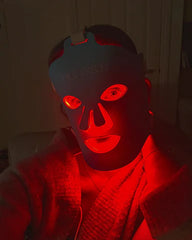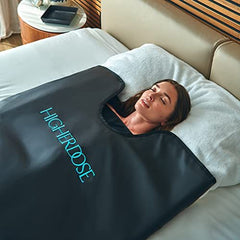
Red light revolution: should you be jumping on the red light therapy bandwagon?
|
|
Speak to any serious biohacker, and red light therapy is one of the top hacks in their toolbox. But what exactly is it and does it really deliver when it comes to its professed health benefits?
Written By Marianne Sheena - Nutritional Therapist specialising in gut, hormonal and adrenal health. Her approach focuses on combining dietary changes with lifestyle and biohacking techniques to rebalance and restore optimal health
Origins
Red light therapy (RLT) is a type of photobiomodulation, defined as "a form of light therapy that utilises light sources". Although it has only risen in popularity in the last couple of decades, the use of light as a therapy in modern medicine can be traced back to the beginning of the 20th century. In 1903, after observing the benefits of sunlight exposure, Danish doctor, Niels Finsen, won a Nobel Prize for his pioneering work in treating skin diseases and scarring with red and ultraviolet light.
Fast forward to a century later, and NASA researchers were attempting to use red light to boost the growth of plants in space. Not only did they achieve this, but the scientists also noticed that while being exposed to the red light waves they themselves experienced quicker wound healing. A subsequent 2001 NASA study demonstrated that red light did indeed promote cell growth and accelerated healing of musculoskeletal injuries and wounds in Navy SEALs.
Since 2001, the research supporting the benefits of red and infrared light therapy has expanded exponentially, with many professional sports teams, functional medicine practitioners and wellness centres now incorporating red light techniques into their practices.
So what exactly is red light?
To dive into this we need to look at the light spectrum. From a therapeutic perspective, red light can be categorised into four main forms: red, near-infrared, mid-infrared and far-infrared. Whilst all provide certain health benefits, each has different impacts attributable to their differing wavelengths.
What does this mean for your health?
Research has shown that RLT can provide a myriad of health benefits. These include:
Energy
A key property of red light is that is stimulates the mitochondria, the energy-generating structures in our cells, and increases their ability to produce adenosine triphosphate or ATP, the molecule we use for cellular energy. This means we have more energy for our daily activities, as well as for healing functions in the body.
Skin health and ageing

Now used extensively in anti-aging spa treatments, red and near-infrared light have both been shown to rejuvenate the skin, through stimulating collagen production and boosting blood flow and circulation. This increase in blood flow in turn increases the transport of oxygen and vital nutrients to skin cells, allowing them to produce the energy needed for healing and regeneration, and as a result improving skin tone and texture, reducing fine lines and wrinkles, repairing sun damage and fading scars and stretch marks.
As if that wasn't impressive enough, RLT's ability to reduce inflammation and improve immune defence against microbes, including bacteria, means that it has also been shown to be effective in treating and preventing acne, as well as reducing the risk of long-term scarring.
Hair growth
Early research has also shown promising results when it comes to the impact of RLT in stimulating hair growth and increasing hair thickness in individuals suffering from hair loss. This is thought to be due to the combination of increased mitochondrial energy production and reduced inflammation which extends the time hair follicles remain in the anagen (growth) phase before transitioning to the catagen (degeneration) phase.
Cognition and sleep
The red-light induced uplift in energy, together with increased blood flow and reduction in inflammation are also beneficial to brain function. Not only does the research show that RLT improves cognition, boosts mood and enhances sleep, but a recent study has also shown that photobiomodulation applied to the forehead for a period of eight weeks significantly reduced anxiety levels. With ever-increasing research in this area, there is now also compelling evidence for RLT’s therapeutic effects in treating traumatic brain injury, stroke, Alzheimer's disease and Parkinson's disease.
Chronic pain relief and muscle recovery

Red light suppresses inflammation, which combined with its role in promoting circulation, reduces muscle pain and joint pain and supports exercise recovery. So the perfect way to revitalise your muscles after a heavy gym session!
Hormonal balance
Renowned biohacker Ben Greenfield caught everyone's attention when he announced in Men's Health magazine that “I Put a Giant Red Light on My Balls to Triple My Testosterone Levels”! Before anyone jumps straight on Ben's bandwagon, it's important to note that research in this area is still in its infancy, so while initial animal and small scale human trials are showing some promise, this is not necessarily backed up by solid science at this stage. Even more important to highlight is that certain RLT products give off heat which is certainly NOT beneficial for testicular health! So any adventurous male biohackers may want to apply caution before following Ben's lead.
Research on the hormonal benefits for females is similarly at nascent stages, with a small population trial suggesting that RLT promotes progesterone production and balances oestrogen levels.
How do infrared saunas compare to other red light therapies?
Infrared saunas typically use mid-infrared light and far-infrared wavelengths to generate the heat which makes us sweat. Since these penetrate deeper into the body, they trigger different physiological impacts. While offering similar benefits to red and near-infrared light therapy when it comes to reducing muscle aches and improving exercise recovery, infrared saunas also provide cardiovascular and detoxification benefits. Research has shown that even just a single 30 minute sauna session can decrease blood pressure by between 5-10% due to blood vessel dilation and increased blood flow circulation. The sweating triggered by heat of the sauna has also been shown to increase the body's excretion of toxic elements, including heavy metals. One word of caution though – saunas and alcohol do not mix well! This is because both have blood pressure lowering effects and can also be dehydrating. So it's best to keep saunas sessions away from any drinking binges, and instead hydrate with water and electrolytes to replenish minerals lost through sweat (LMNT or Bodybio Elyte are both great options).
Are there any other aspects of RLT you should be cautious about?
While red light therapy is considered to be a relatively low risk technique, it is important to be aware of dosing. If using LED panels, Ari Whitten, author of "The Ultimate Guide to Red Light Therapy, recommends keeping the device at least 6 inches away. And whilst there's no definitive guidance on the length of time you should be exposing yourself to red light, as with many biohacks more is not always better, with over-exposure reducing the benefits. Many experts consider 10-20 minutes 3 to 5 times a week to be the optimal range and, as with most new health approaches, it's sensible to start slow and build up gradually.
Nevertheless, with such impressive benefits and low-risk safety profile, who wouldn't want to give RLT a go?!
So how can you access the benefits of right light therapy?
As the technology has increased in popularity, there are now a range of red light devices available on the market so that you can benefit from photobiomodulation therapy in the comfort of your own home. These typically provide red and near infrared light through LED bulbs and can offer whole body panels or pads for targeted exposure, like the HigherDOSE Red Light Mask which provides a facial rejuvenation treatment (see Nutrition Editor Eleanor Hoath's experience of testing it out!)
If you're more interested in the benefits of mid-infrared light and far-infrared wavelengths, you may want to try out the HigherDOSE Infrared Sauna Blanket.